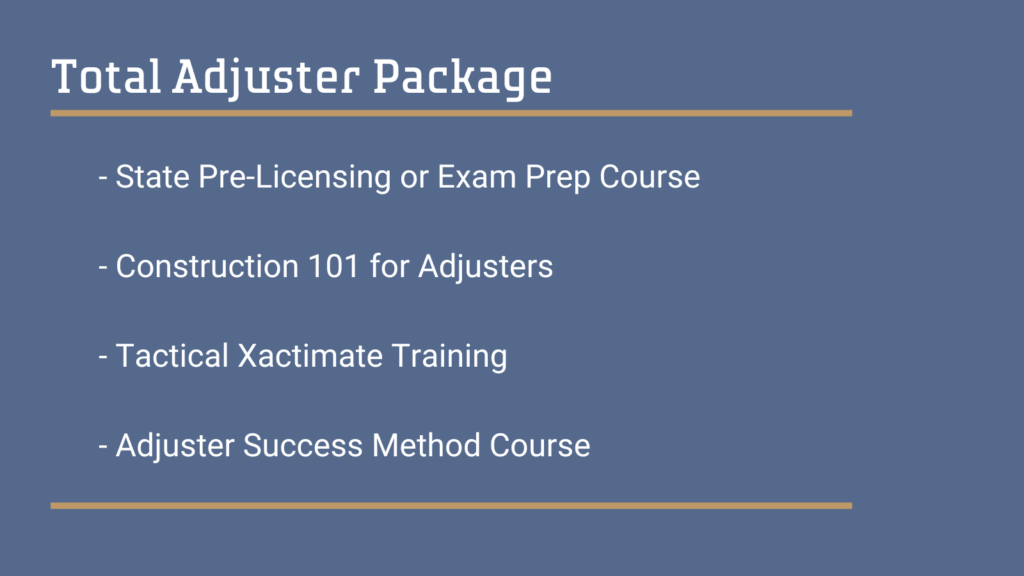We’re often asked by prospective students just how much training is actually needed to succeed as an independent adjuster.
It’s a great question and while there isn’t really a one-size-fits-all answer, we would offer the following friendly guidance: get as much training as you can. Always be looking to further your knowledge and improve your skills. It’s great for your brain and even better for your career!
With that being said, let’s look at some specifics. First, it should be stated emphatically that you will need to get your license and to do that, you need a pre-licensing or exam prep course to help prepare you to pass your state test and get your license. (That’s where AdjusterPro can help!) But let’s say you’re past that first step. You have your license and you want to know what’s next.
It’s important to note that pre-licensing and exam prep courses are primarily concerned with teaching basic insurance terms and concepts, and then secondarily with teaching particular aspects of policy. So they are vital to being prepared to pass your exam.
What they are not concerned with, however, is basically anything else related to the job itself. Things like how to measure a roof, analyze property damage, interact with the insured, or any other of the highly practical skills required in the everyday business of adjusting. Unless you have 20 years of construction experience, have been writing estimates all along in Xactimate, and have ridden along with your buddy on multiple property scopes and helped collate and submit the claims files, then you will want and need some additional training.
So we recommend doing anything you can to learn the business. Know an adjuster? Ask them if you can tag along on a couple of their claims. This will show you where the rubber meets the road and will be indispensable in forming your mind’s eye to see as an adjuster would. Spend some time in and around construction, even if it’s volunteering for Habitat for Humanity on the weekends or helping your uncle build his deck. The same goes for the insurance industry. Take any opportunity to familiarize yourself with these industries, their concepts, and their basic terminology.
Next, Xactimate Training is one of the most important things a new adjuster can do to get started. Even for those intimately familiar with construction and even Xactimate, it’s likely these areas aren’t understood in the particular context of handling an insurance claim. Or, more to the point, understood in the light of how a claims office and their file review department want you to understand them. You might understand the machine, but it’s just as important to know how and where to grease it. Xactimate training takes you further into the process by initiating you into the artful science of writing a software-based estimate that will win you friends in file review.
It’s also worth noting that when surveyed, our alumni say that Xactimate is both the most important to know AND the most difficult skill to learn for new adjusters.
Once you’ve mastered, or at least laid the foundation in these areas, you should consider further certification and training. Carrier-specific certifications and supplemental training may just mean all the difference to a potential employer. Things like the California Earthquake Adjuster Accreditation and the NFIP Certification won’t be used every year, but when the next big earthquake rocks California, adjusters with those certifications will be the first on deployment.
Carrier-specific training, such as the State Farm Certification, is becoming more commonplace and can often be required by a prospective employer. It’s important to sign up on rosters of the companies listed in the article above so you get notified when they host trainings or offer the opportunity to obtain your certifications.
The main takeaway here is that by adding certifications, training, and additional licenses, you add credibility to your resume and expand your opportunities for deployment. Which particular courses to take depends on your own interests, feedback from potential employers, and time/budget constraints.
In summary, don’t just stop with licensing. If you had a driver’s license but had never been behind the wheel before, the license isn’t going to magically turn you into a good driver. Supplement with Xactimate training, add certifications where appropriate, and lay a strong groundwork for a long and successful career. Now is the time to start!




